feature
Soil Texture 5E
Primary students learn about observing properties without leaving the schoolyard
Science and Children—September/October 2020 (Volume 58, Issue 1)
By Laura B. Schneider and Faith Farren
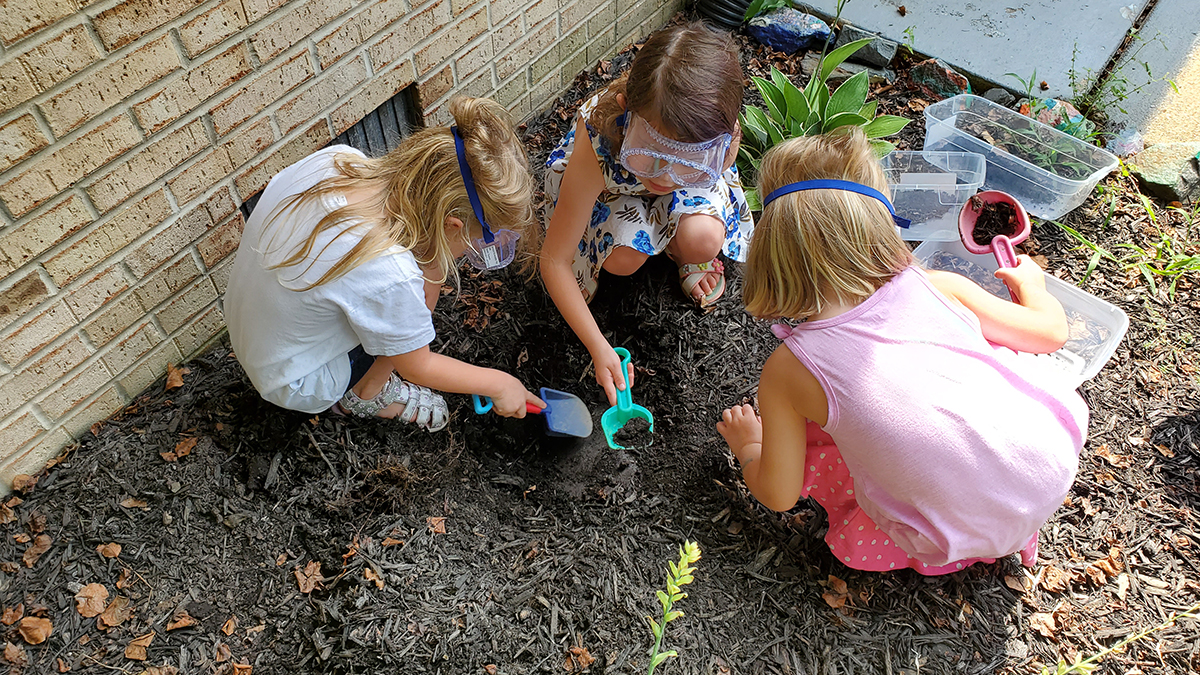
“Let’s go to the garden and use shovels and rakes to get soil!” excitedly exclaims one of our students when we pose the question, “How could we find the differences between beach sand and the soil found outside of our school?” While field trips are an exciting way to engage students in science learning, they may not be feasible. Therefore, we decided to create a 5E (Engage, Explore, Explain, Elaborate, Evaluation; Bybee 2014) field experience for our multi-aged primary class where our learners would investigate soil samples in our school yard and compare and contrast them with a sample from a local beach. By designing and leading the experience, we could meet our goals of teaching students about properties while modeling our field investigation after the framework of exemplary practices in outdoor and field education (Tal, Lavie Alon, and Morag 2014). We chose to follow “high quality practices” including:
- Activity and action: involving students in meaningful discussion and investigation encompassing phenomena that are better understood in an outdoor environment.
- Involving the classroom teacher: because we know our students and the standards.
- Using the environment: learners use their senses to experience the outdoors while we value student exploration, observations, and questions.
- Encouraging the field experience as a social learning event: student and teacher interaction and discussions were valued.
When designing our field experience we focused on the performance expectation: 2-PS1-1: Plan and conduct an investigation to describe and classify different kinds of materials by their observable properties. It is inherently multidisciplinary since the physical science construct of properties is being addressed through soils. Soils are not just something with texture; each sample is unique because of its history. Soils support life on our planet through plants that grow in soils and organisms that live in the soil (NRC 2012). Therefore, we wanted to teach soil properties, the diversity of soil types, and their importance to the Earth System.
In light of the COVID-19 pandemic, we have included adaptations that can be made for student grouping, materials, and social distancing, to reflect current safety practices.
Formative Assessment
We asked learners to share their knowledge on soils by posing questions through a Think-Pair-Share format. Questions included:
- What can you tell me about soils?
- What are soils made up of?
- Where can soils be found?
- Are all soils the same?
- What do you think it means to observe in science?
- What do you think the word property means in science?
Prior knowledge stemmed from student experiences in gardening or composting. They understood organisms lived in the soil, plants need nutrients from soil, and that “food could be broken down to make food for plants” (composting). Our students knew that soil came from gardens, but were unsure where else to find soil and what composes soil. They understood that soils were different because some had more food for plants (nutrients). Our findings fit with the common misconception that students believe soils are “brown and homogeneous,” which is incorrect since there are a variety of soils with different appearances and compositions (Annenberg Foundation 2017). Students had confusion with understanding the terms observing and properties, though they had prior experience with this vocabulary.
Day 1: Introduction to Properties and Observing
Engage
A mystery bag activity introduced the idea that sense of touch is an important way to observe. Six opaque plastic bags (labeled 1–6) held ordinary objects: feathers (fluffy, soft), melting ice (slippery), seashell (rough), ball of yarn (squishy), marble (smooth), Lego brick (bumpy). Strategic grouping was used to pair younger learners with older students, and each group had a set of bags to explore using only their sense of touch. Students could be grouped on the floor or tables depending on which allows for spacing of students. Removable tape marks could be used to guide students to sit appropriate distance from each other. Instead of giving each group a set of bags, each student could get their own set which the teacher could distribute and pick up. Students recorded observations on mystery bag data sheets (Figure 1), where they made an inference by drawing what they thought was in each bag. Various accommodations included an adult helping children sound out the words or helping them trace the letters to make words. After sharing ideas with the whole class, it was revealed what was in each bag. This guided students to make the connection that scientists classify objects based on their properties.
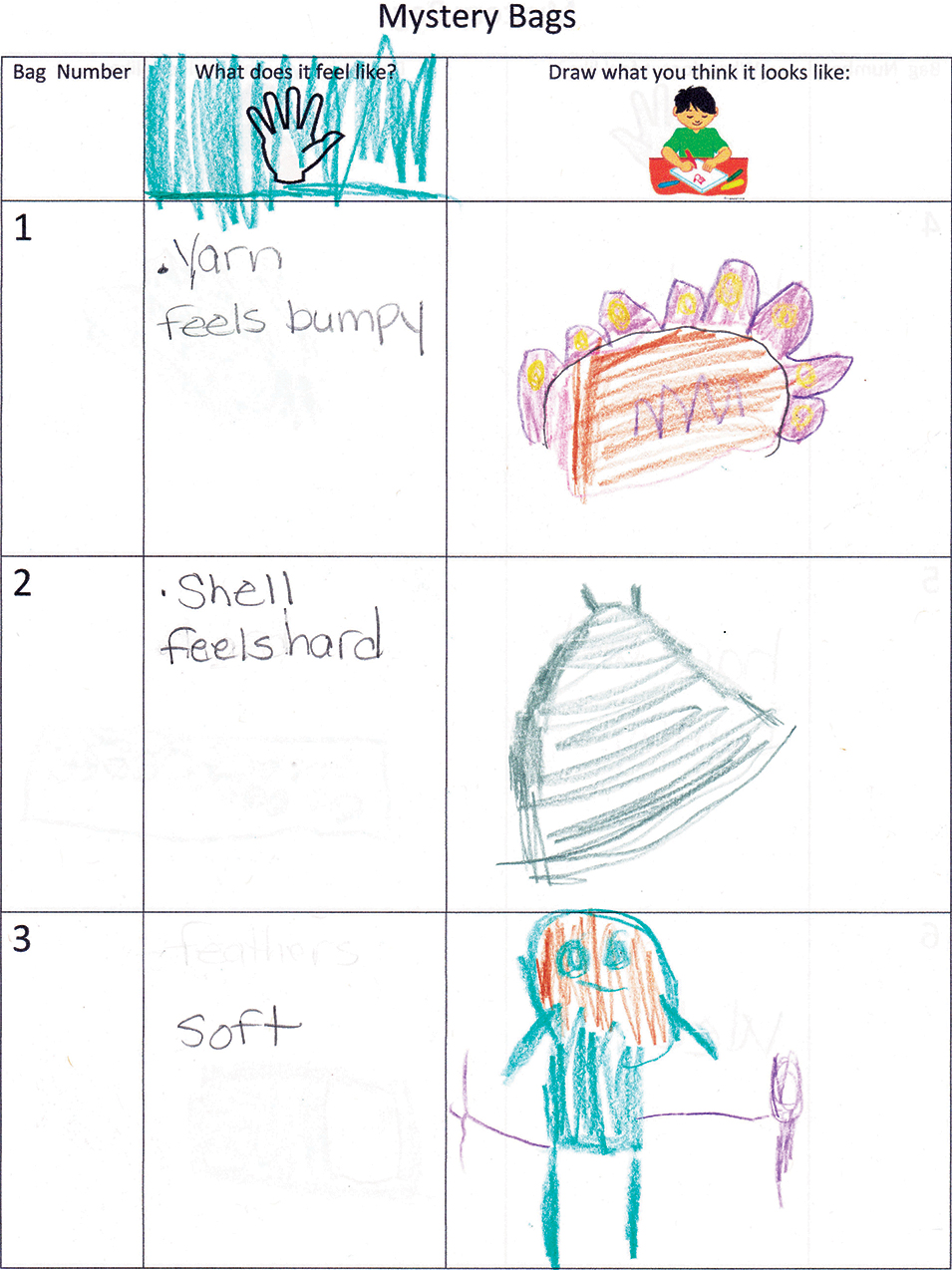
Mystery bag data sheet.
Explore
Our research question asked, “How is beach sand different from soils found outside our school building?” Examining sandy soil was a perfect way to address the misconception that all soils are the same. Since it was not feasible to take the class to the beach, we collected a box of sand from a local beach and took photographs that showed plant matter growing at the beach, then brought it in for students to explore. Instead of putting sand in large boxes that a group of students would touch, the teacher could purchase clear drinking cups or recycle small yogurt cups and fill them with sand and then hand each student their own sample cup to explore. If it is not possible to collect a local sand sample, another option would be to purchase a bag of playground sand.
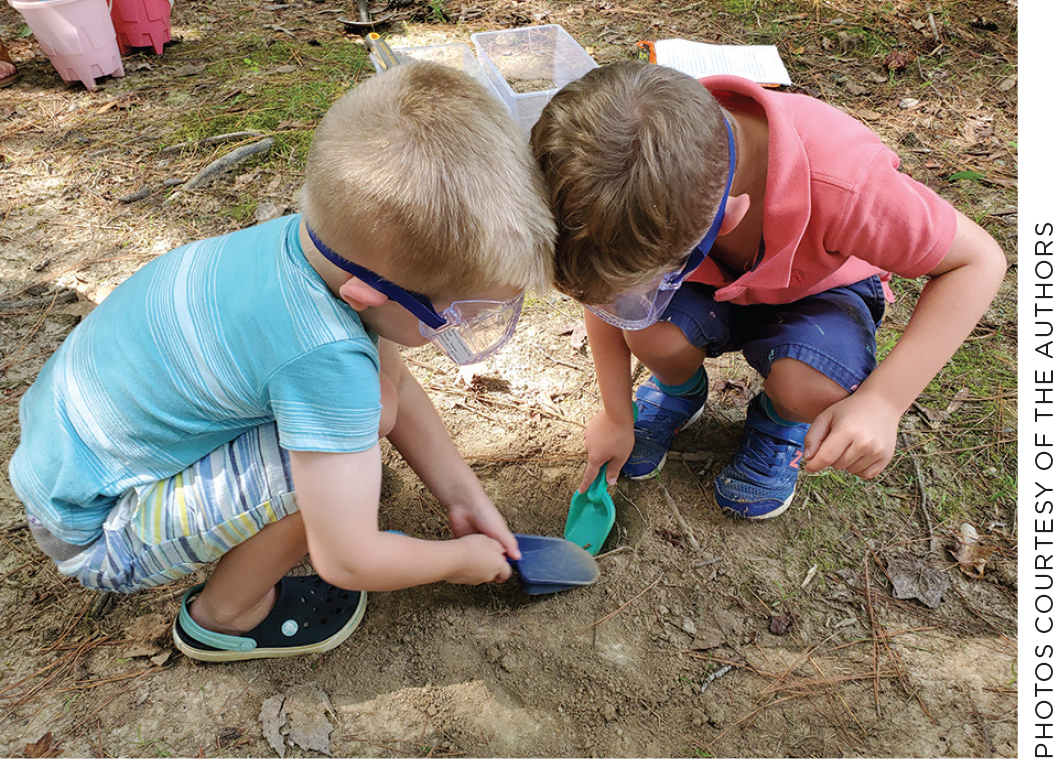
Students dig soil samples in different areas.
Students, in the same groups, explored sand using their senses. They were encouraged to look at sand through a magnifying lens as well as with the naked eye. Students wore goggles during any interactions with soil for safety reasons. We helped guide students in observing geologically relevant properties such as grain size and color, since students can often have difficulty picking out relevant features (Ford 2004). Students shared their observations with their group first and then the whole class. Observations were recorded on chart paper (Figure 2) so that we could interact meaningfully with students and so that ideas could be examined together (Tal, Lavie Alon, and Morag 2014).
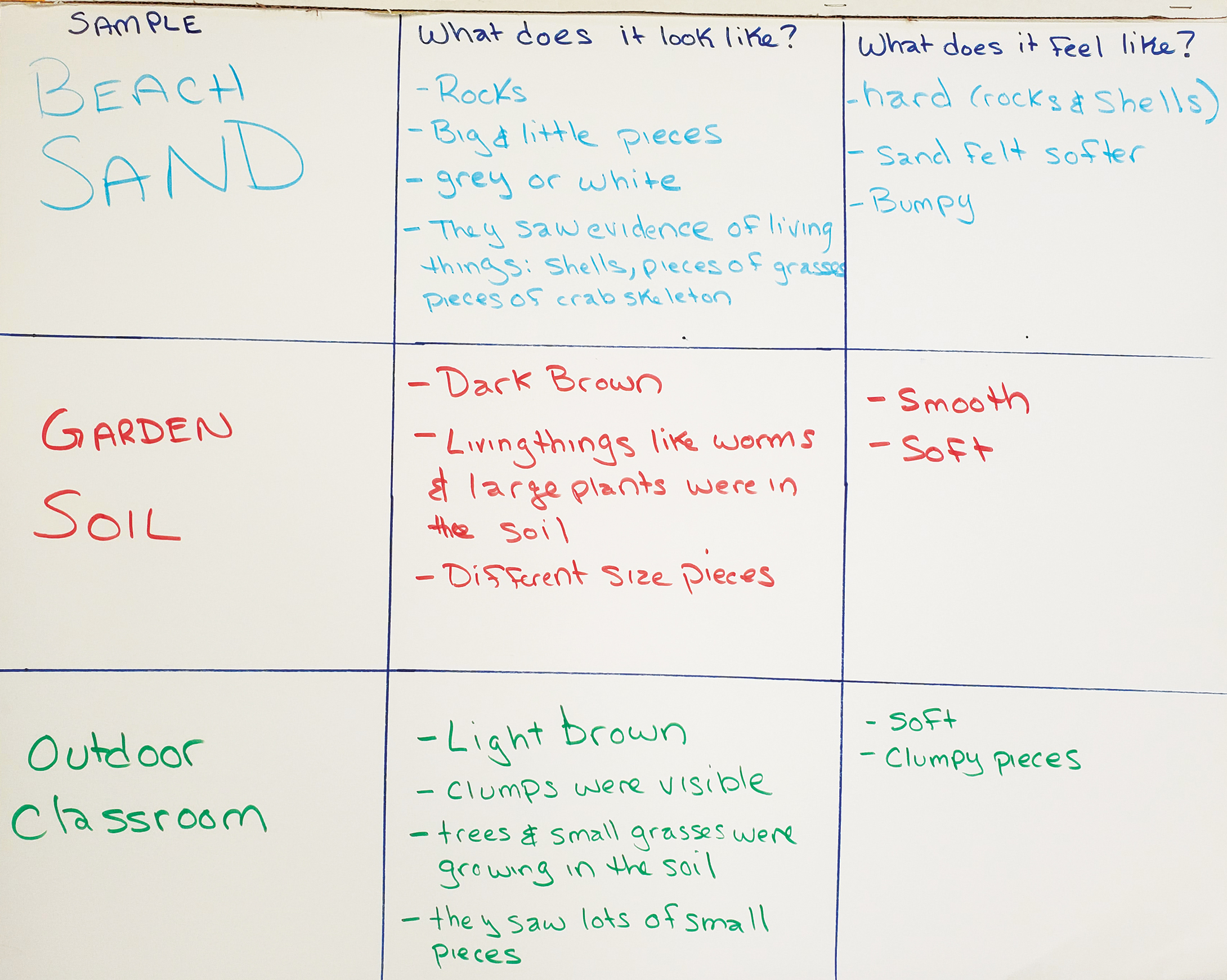
Class observation chart.
To have learners use the science practice of planning and carrying out an investigation, we reiterated, “How is beach sand different from soils found outside our school building?” We asked them how we could find the answer and guided them using these questions:
- Where would we need to go to collect data?
- What tools could we use?
- What data could we collect?
Students were excited to share ideas and have the autonomy to choose where to collect samples. This afforded them the opportunity to experience “activity and action” of investigating soil texture with meaning (Tal, Lavie Alon, and Morag 2014). Our students decided to go outside to find different types of soil and survey prior to digging. They suggested using sandbox rakes/shovels for “getting the soil out of the ground.” We also included a metal gardening shovel if samples were too hard for the smaller toy shovels. If the school does not have enough shovels and rakes for students to use their own tool, prior to the activity, students could be asked to bring one in from home in a plastic bag with their name on it. Students who are not able to bring in their own tool should be provided one. Students determined data collection categories: color of the soil, worms or insects in it, and how it felt when touched. One student recommended looking for vegetation in the soil such as “flowers or trees.”
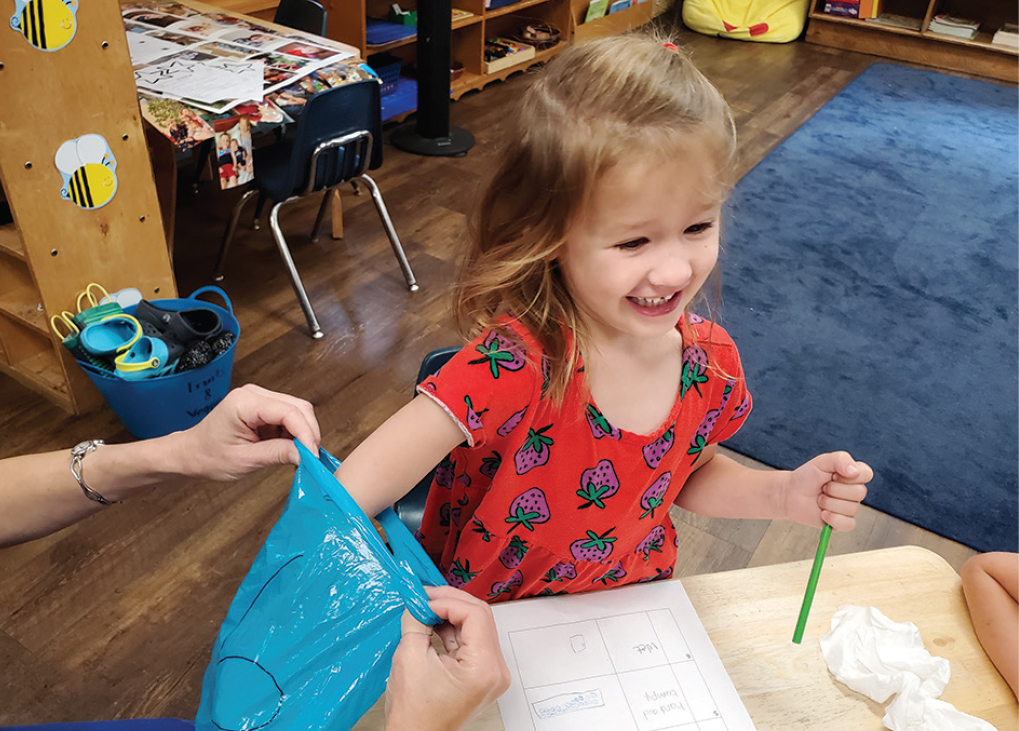
A student explores a mystery bag.
Prior to taking students outside, sunscreen and insect repellent was applied (Follow your school guidelines for outdoor exploration). Two teaching staff members and a parent volunteer assisted in providing accommodations and monitoring during the excursion. Strategic student grouping was implemented. Before heading outside, all materials were placed in a wagon (shovels, rakes, and empty plastic shoe boxes). We asked students to share their ideas on staying safe while having fun outside. They explained they should stay with their chaperone, walk with the group, and listen to what friends were saying. We discussed how to use the shovels appropriately and had students’ put on goggles to prevent getting dust in their eyes.
Heading outside, adults were at the front, middle, and end of the line to support students and for safety. We worked to make this activity inclusive, with learning accommodations implemented as needed, using accessible ramps, and strategic pairing for the greatest learning potential. We had a “stop and look” hand signal; helpful in outdoor environments where hearing a teacher can be challenging. If needed, longer or curved shovels could also be used as an accommodation for individuals with limited mobility that would have a hard time bending to use a short shovel, such as those with physical issues or in a wheelchair.
Our group walked around the school grounds and examined soils as a way to engage our learners in “using the environment” as they experienced what they could see, feel, and touch in nature (Tal, Lavie Alon, and Morag 2014). Students opted to take soil samples from the school garden and the “outdoor classroom,” a nature area near the trees. At each site, shovels were used to dig and collect soil into a box. A possible modification to keep students distanced would be to have them put their own soil samples in plastic sandwich bags and then only touch and observe their own bags. Learners observed both environments and shared observations as a way to value this as a “social learning event” (Tal, Lavie Alon, and Morag 2014). Students were especially excited to spot worms while digging, leading to discussion about soil being a home for organisms.
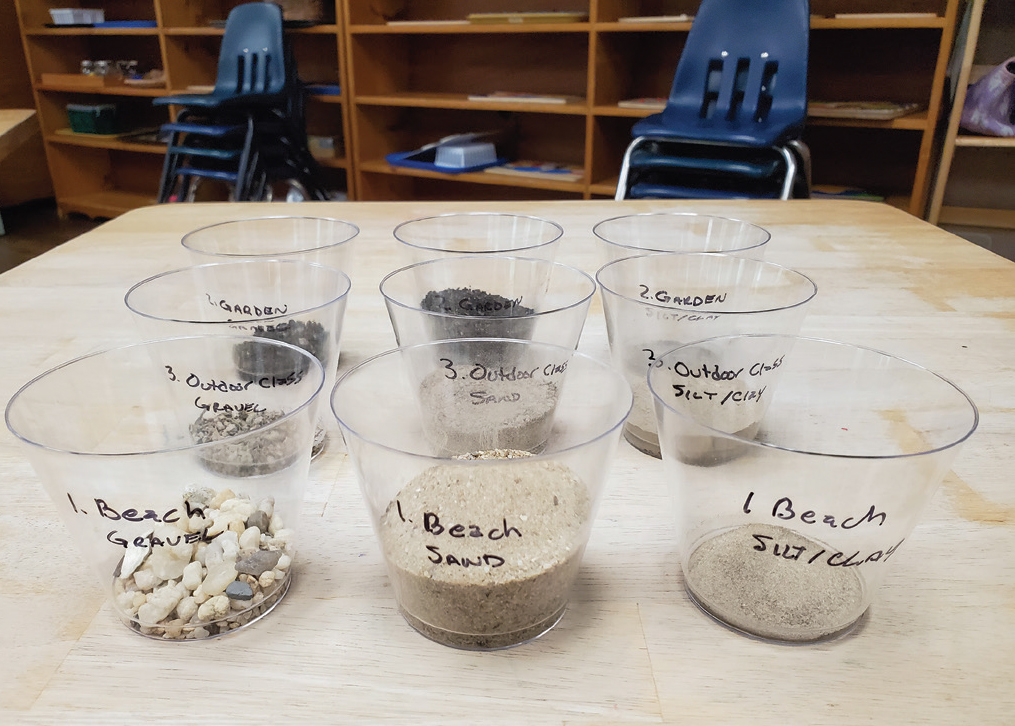
While outside, students shared personal experiences and background with various soils. Our school community includes military families, learners from different nationalities, and students who have lived abroad. This is a way to value their funds of knowledge through having them share about soils and how the environment looks in other places that they have lived.
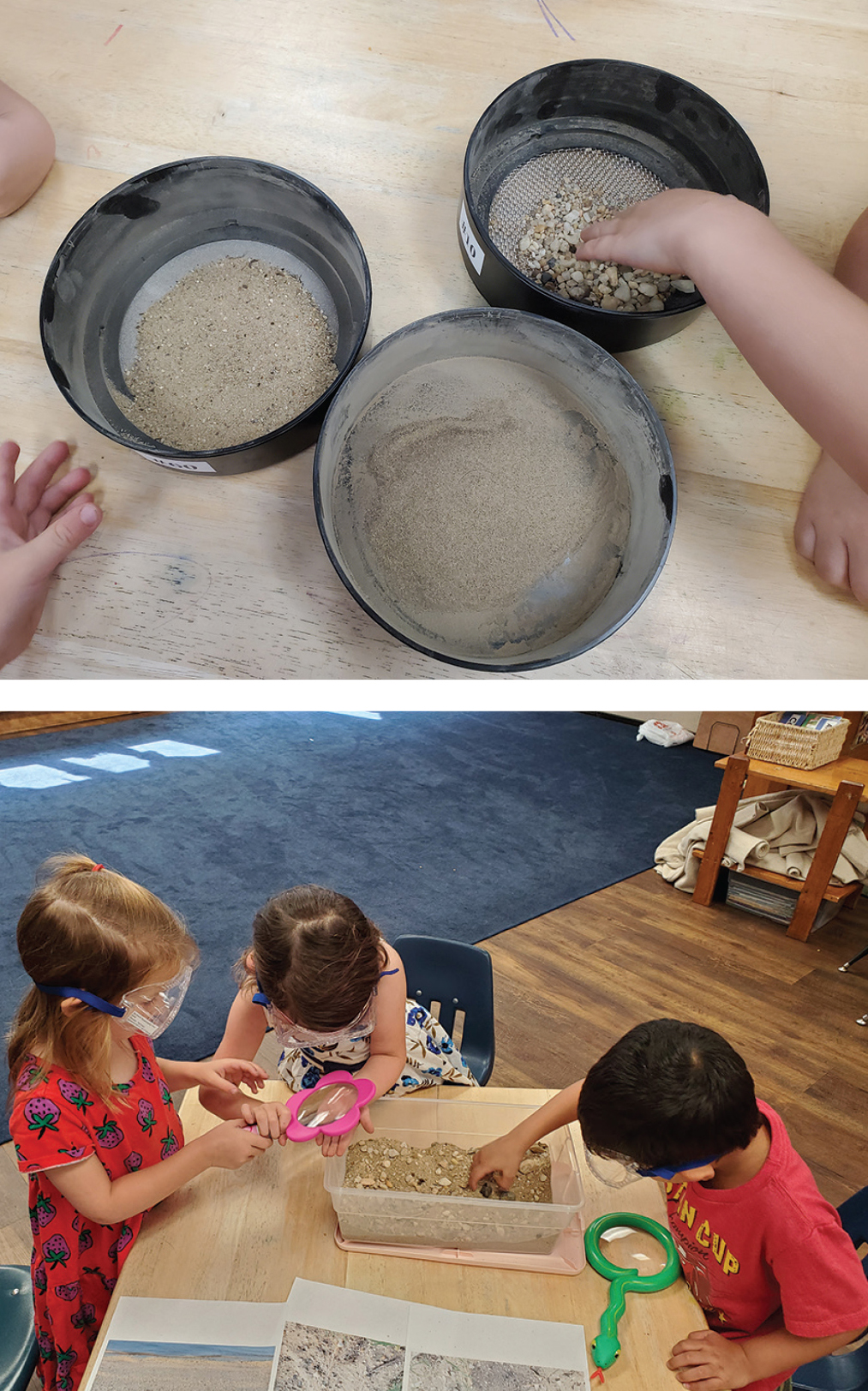
Samples were brought back to the classroom, where students verbally shared their observations and added them to the existing chart. We had a class discussion where we talked about the crosscutting concept of patterns while comparing and contrasting our three samples.
Soils samples were saved and dried for later use. To dry the soil, samples can be placed in a box and sundried for multiple days. Once dry, the clumps of clay can be broken using a rubber mallet or mortar and pestle.
Day 2: Examining Soils
Explain
Pictures can be downloaded or printed from the internet prior to starting this portion so that students can see a variety of soils during the discussion. Students sat in our circle time area to discuss soils. Name tags or removable tape can be used to help make sure students are sitting an appropriate distance from each other. We activated prior knowledge by having learners recount previous observations. Students discussed how samples felt different, which was used as an avenue to define texture. We explained soils are composed of broken down rock and sediment and that they have water and air in their pore spaces (Marshak 2005). We also discussed that they hold nutrients and water, which are important for life. Students were asked to think back to the mystery bag activity and talk about what objects were used and what they felt like. This was then related to soil texture and to grain size, as we explained that each size grain would feel differently when it was touched. It was also important to define organic materials. We asked students which soil sample had the most plants growing and then discussed that gray or black soils are richer in organic materials and good for growing plants (Marshak 2005). We defined color of soil as a property and had learners predict which sample they thought had the most organic materials (Marshak 2005). To check for student understanding, we had students draw simple pictures of why soils are important and soil compositions. Students could either label the drawings on their own or have a teacher help.
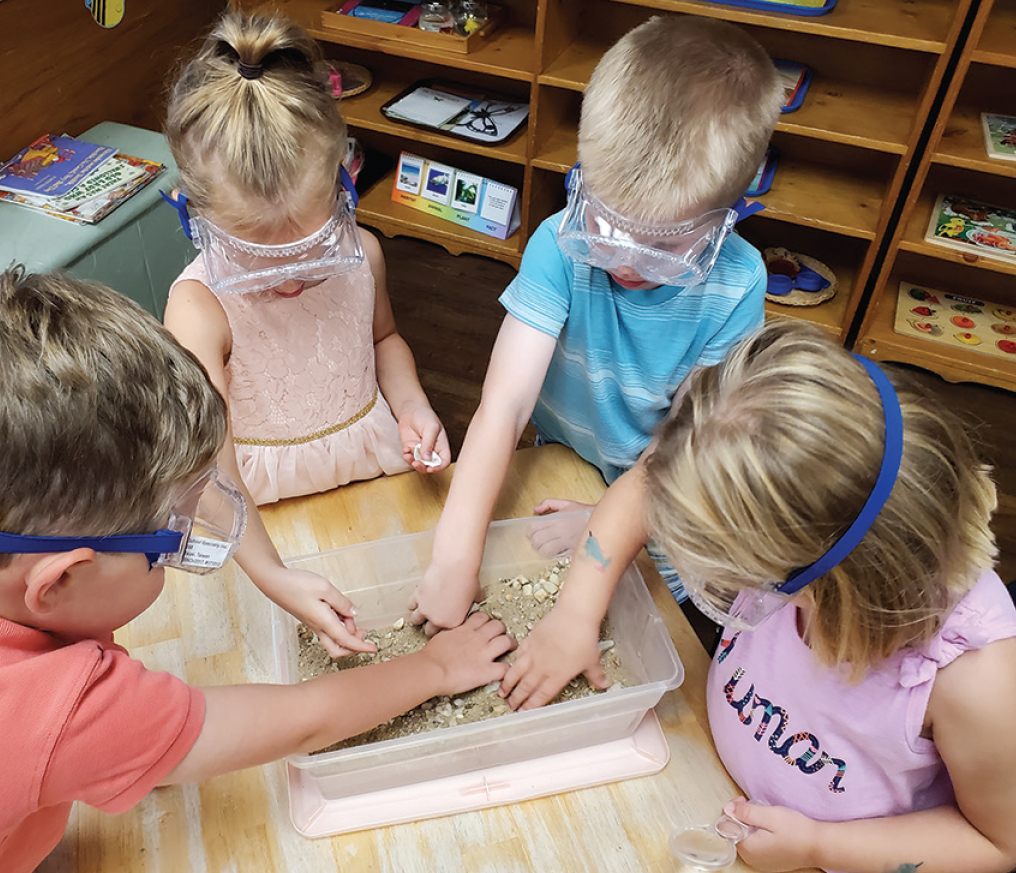
Students observe soil samples.
Elaborate
The aim of this activity was to have students explore how size affects the texture of soils. This was related to the crosscutting concept of scale, proportion, and quantity since the proportion of various sizes of grains determines the texture. We asked students “When you play in a sandbox, what could you use to separate pebbles from the rest of the sand?” This led to answers of a sand sifter, so we had them look at and compare a sand sifter with a soil sieve. Our soil sieve included mesh sizes #10 and #230, which could sort particles into gravel, sand, and silt/clay. If a sieve is not available, a toy sifter or kitchen strainer could be used to separate particles, though it will not allow students to explore specific particle sizes. Like the previous activity, goggles for safety, strategic grouping, and accommodations were implemented. A student used a measuring cup to measure 100 mL of soil, which was poured into the top of the sieve by another student and then shook. Students took turns shaking the sieve. The teacher could either use cleaner to wipe off the sieve between students or the teacher could choose to shake the sieve and have students watch. Contents of each pan were each poured into a clear plastic cup. This allowed students to compare the scale of grains that are gravel, sand, and silt/clay. This process was repeated for the other two samples, allowing for maximum participation.
Each sample produced a cup of gravel, sand, and silt/clay size grains. Cups were lined up to compare relative proportions of size particles. Students were able to make comparisons such as: sand had a higher proportion of gravel and sand, and the outdoor classroom sample had a higher proportion of silt and clay. We also discussed how the proportions of different grain sizes as well as nutrients affected the ability of plants to grow. Students went back to answer our original research question relating beach sand to the soils found outside of the school, which helped us hit the Common Core Standard ELA W.2.8, Recall information from experiences or gather information from provided sources to answer a question.
Evaluate
Two summative assessments were used to evaluate knowledge of planning and carrying out an investigation of properties. We used the scenario, “Create an investigation for your classmates where students must describe and classify materials using the properties of color or texture.” Learners were given sentence starters and could either write their own explanation or verbally explain their investigation. Students often proposed sorting activities based on color and common objects such as: art supplies, magnetic blocks, and beads/marbles. Others proposed an activity where students would go outside and look for different textures of natural objects like bark, rocks, and leaves.
Our second summative evaluation asked students, “If you wanted to find out about the properties of a new soil sample, what would you do to design that type of investigation?” Learners often suggested collecting soil from a park or a farm. They were able to articulate looking at color and texture properties and described how sieves could be used to break the sample into “different size pieces.” Many predicted that farm soil would be similar to garden soil, since both were “places with lots of plants growing.” As an accommodation, this could be framed as a performance assessment where a student could use materials to show how to sort by particle size and then describe the color and textures present in the sample.
Conclusion
This field experience is an engaging way for students to design their own investigation of soil texture and get to experience science learning in a field setting. Materials purchased included: a sieve ($55 on Amazon) and nine plastic shoebox size bins ($10). Teachers are encouraged to use their instructional resources and community to acquire supplies. For instance, soil sieves are more common equipment for a high school science classroom, so it may be possible to work with a district science coordinator or supervisor to get permission to borrow one.
This experience raised the level of learning for our class. Students were actively engaged in all three dimensions of the Standards while designing a field investigation. Students felt connected to the lesson since they selected soils to explore and dug them themselves. By the end, students were able to explain what properties are and describe how soils were classified based on the properties of color and texture. And all after just a walk outside!
NSTA Connection
Download the mystery bag data sheet, evaluation materials, and NGSS connections at www.nsta.org/science-and-children.
Laura B. Schneider (lbschneider@smcm.edu) is an adjunct professor in the Environmental Studies Program at St. Mary’s College of Maryland in St. Mary’s City, MD. Faith Farren is primary-grade teacher at Starmaker School for Early Education in California, Maryland.
5E Earth & Space Science Life Science Elementary


